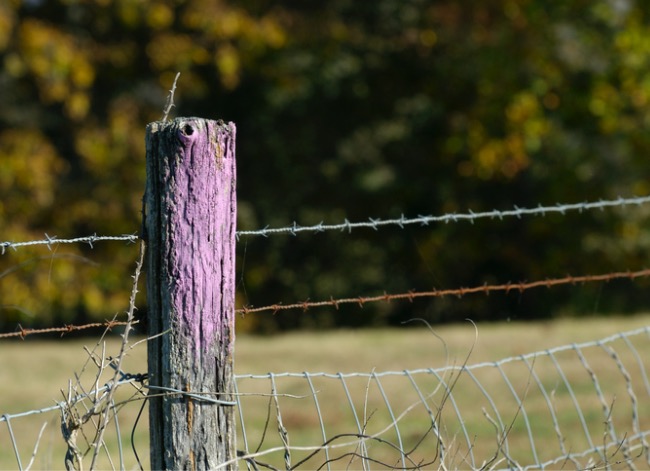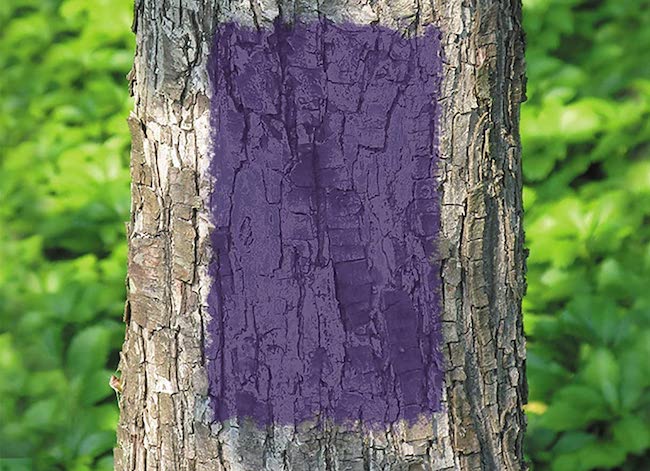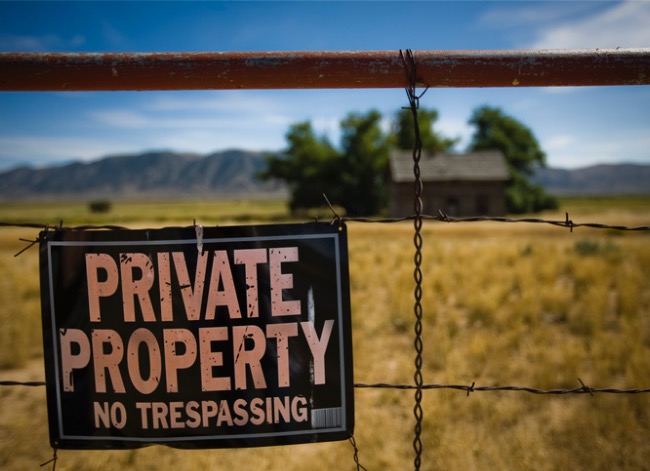

We may earn revenue from the products available on this page and participate in affiliate programs. Learn More ›
The Meaning of a Purple Fence
The term “trailblazing” has become a common metaphor for something that is new or innovative, but it originally referred to marking a path through heavily wooded areas to help guide hikers. If you’ve ever tied a yellow ribbon ‘round an old oak tree or spotted a cairn while out exploring, you are familiar with trail blazes.
This symbolic communication style, however, isn’t limited to just backpackers or day-trippers. With one stroke of a paintbrush, property owners can mark the boundaries of their land, using the color purple to tell everyone to keep out.

Why Purple Paint?
Using signage that’s more suited to city surroundings, some woodland property owners choose to nail metal, plastic, or even cardboard signs directly to a fence post or tree. This way of marking land isn’t foolproof, though. No matter how durable they seem, such placards fall victim to the elements: Printing can fade, cardboard disintegrates, and metal rusts. “No trespassing” signs are also vulnerable to vandals who might tear down, deface, or simply steal them.
As well, affixing a board to a fence is one thing; putting a nail into the nearest oak is quite another. Breaching its bark to insert a screw or nail won’t necessarily kill a tree, but it’s still not ideal. Paint is a better choice all around.
Why purple paint, though? For starters, this hue is highly visible outdoors. Purple is also easy to differentiate from other shades, even for people who are otherwise color-blind.

Where You Might See Fences and Trees Marked Purple
This symbolic shade isn’t new. Arkansas was the literal and figurative trailblazer, enacting legislation regarding special “posting paint” in 1989. Other states followed suit, and today nearly half of all U.S. states have purple paint laws on the books (although some states specify other colors). These laws vary by location. In Texas, for instance, purple paint stripes on posts or trees indicate that the land is off-limits to all trespassers. Outdoor enthusiasts in North Carolina, however, can cross such boundaries as long as they do not engage in hunting, fishing, or trapping.

What Happens if You Don’t Abide by Purple Paint Laws?
As legal offenses go, criminal trespass is one of the oldest in the world, dating back to 13th-century England. One of history’s most well-known—and, indeed, celebrated—trespassers, Robin Hood, quite literally risked his life and that of his sidekick, Little John, simply by camping out in Sherwood Forest. These were royal lands, remember, where simply shooting an arrow was punishable by the removal of the offender’s thumb and first finger.
Today’s trespassers aren’t subject to such harsh consequences, of course, but there are nevertheless penalties for disregarding purple paint or other no-trespassing messaging. Being convicted of criminal trespass can result in jail terms lasting months or even years as well as up to $10,000 in fines in certain jurisdictions. So before you set foot in the wilderness, make absolutely certain that your use of that land is lawful.

Tips for Using Purple Paint on Your Property
If you are a property owner, brush up on the local guidelines before you head out, paint can in hand. Your purple stripes must be vertical ones and must conform to specific measurements:
- At least 1 inch wide
- At least 8 inches long
- Between 3 and 5 feet from the ground
- Spaced no farther than 100 feet apart
For marking fence posts, any type of paint will work, so feel free to use whatever’s left over from a painting project. For trees, use only latex paint, not oil-based; the latter can be harmful to trees. Better yet, avail yourself of spray paint specially formulated for this very purpose.
Purple paint can help protect property, plants, people, and wildlife, but it can do this only if it’s clearly visible. If you’re marking your property, make sure your purple paint can be seen easily by passersby and potential trespassers, and help spread the word about its meaning. Discuss the significance of purple paint on social media, and talk to your neighbors about it. Come hunting season, write a letter to the editor of your local paper. Your efforts to protect your property will pay off only if others know the significance of the purple paint.
